Hobbling A Horse
What is hobbling? How is it used? Is it safe? Will it scare or hurt my horse? Can it be a good training tool? Let's take a look at hobbles and hobbling.
A hobble is a device that prevents or limits the locomotion of a human or an animal, by tethering one or more legs. Although hobbles are most commonly used on horses, they are sometimes used also on other animals. On dogs, they are used especially during force-fetch training to limit the movement of a dog's front paws when training it to stay still. They are made from leather, rope or synthetic materials such as nylon and Neoprene. There are various designs for breeding, casting and mounting horses. Hobbles can be an extremely useful tool in horse training if used properly. the "sacking out" technique tis used to give your horse confidence by reducing his fear of objects and noises, thus reducing his fight or flight response and it helps to enforce your leadership position. Hobbles can be used quite effectively in this process and in so doing teaches your horse pressure and release and builds trust. This process of sacking out and the use of hobbles desensitizes a horse's legs to being confined, trapped or stuck. If hobbles are used improperly they can break a horse' spirit, and cause physical and psychological injury to your horse. The yourtube video below can prove to be quite beneficial.
Types of Western Hobbles
"Western"-style horse hobbles are tied around the pasterns or cannon bones of the front legs of the horse. They comprise three basic types:
- The vaquero, fiador or braided Hobble - These hobbles are often of a quite fancy plaiting and lighter that other varieties and are therefore only suitable for short term use.
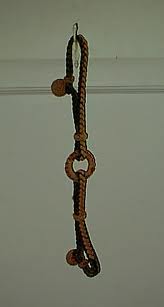 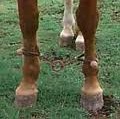
Vaquero, braided or fiador Hobble
- The figure eight hobble or Queensland Utility Strap - A common style of hobble that stockmen wear as a belt and can be used neck strap, lunch-time hobble or a tie for a "micky". (micky bull) This hobble is made with three pieces of leather and two rings, plus a buckle fastening.

Figure 8 Hobble
- Twist hobble - This hobble is made of soft leather or rope and has a twist between the horses legs.
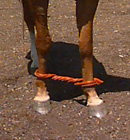
Twist Hobble
The above patterns are unsuitable for training as they can tighten around a leg and cause injury.
Western hobbles are normally used to secure a horse when no tie device, tree or other object is available to secure a horse. When traveling across open lands, if a rider has to dismount for various reasons, the horse can be secured. Hobbles also allow a horse to graze and move short and slow distances, but prevent the horse from running off too far. This is handy at night if the rider has to get some sleep so in the morning he can find his horse, not too far away.
Hobble training a horse is a form of "sacking out" and desensitizing a horse to accept restraints on its legs. This helps a horse accept pressure on its legs in case it ever gets caught up in some barbed wire or fencing. A hobble trained horse is less likely to pull, struggle and cut its legs in a panic, since it has been taught to give to pressure in its legs.
Other Types of Hobbles
- Drovers' or Grazing Hobbles - They have a buckle on a wide double redhide or chrome leather strap and a swivel and 5 ring chain connecting them. They are placed around the pasterns.
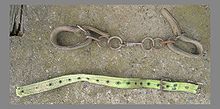
Drovers' and Cattle Hobbles/Western horse hobbles
- Sideline Hobbles - May be made in the same manner as above, but with a longer chain to hobble a front and back leg. Rope may also replace the chain. They, too, are placed around the pasterns. This pattern may be useful on a persistent jumper or a horse that has mastered the art of travelling in front leg hobbles.
three or four leg hobbles are made in a similar pattern to the above and hobble three or four legs. Used for securing legs for operations etc.
humble or one leg hobble is a strap is placed around the front pastern, and then the leg is lifted and the strap is wrapped around the upper leg and then buckled, leaving the horse with three legs to stand on.
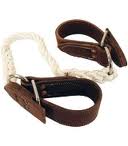
Sideline Hobbles
- Mounting Hobbles - These are knee hobbles that are made with a quick release, on a lead that passes to the rider. They are used to mount fractious horses and when mounted the rider can retrieve them.
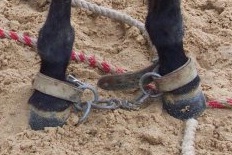
Mounting Hobble
- Picket Hobble - This hobble is a single hobble that is placed on a front pastern and then attached to a tether chain.

Picket Hobble
- Breeding or Service Hobbles- This type of hobble is usually fastened around a mare's hocks, pass between her front legs to a neck strap. They are used to protect a stallion from kicks.
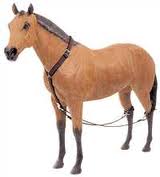
Breeding or Service Hobble
- Hind Leg Pull Up Strap - This passes from a neck strap and around a hind pastern to draw up a hind foot for shoeing or treatment.
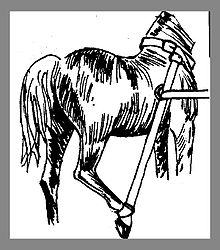 
Hind Leg Pull Up Strap
- Casting Hobbles - These hobbles are the same as the above, but with another rope or strap attached to the other hind foot. When these straps or ropes are pulled up together the horse will fall.
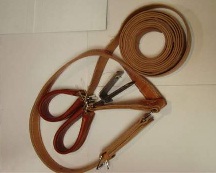
Casting Harness and rope
- Hopples (sometimes called hobbles) - These are a piece of equipment used by Standardbred pacers to help the horse maintain its pacing gait.
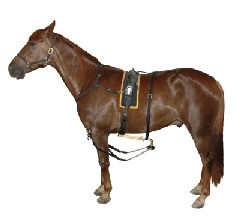
Hopple Equipment for pacers
- Cattle Hobbles - These are a strong strap with a metal keeper in the middle and a buckle at the end. They are used on the hind legs for a short period when capturing feral cattle. Not used on horses.
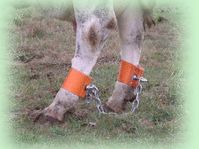
Cattle Hobbles (Not used on horses, ever!)
- Camel Hobbles - This particular type of hobble is used primarily on camels. Occasionally they are used for horses but can be quite dangerous because they can cause a horse to hyperextend a knee joint. They can also cause a horse to go into flight mode out of fear.
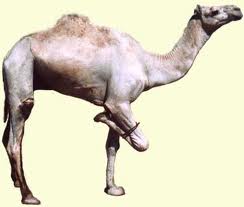
Camel Hobbles
Some Benefits of Training With Hobbles
- Teaches horse patience
- Horse learns to give to pressure
- Reduces panic and injury if legs are trapped
- Secures horse from travelling too far if not tied
- Builds trust
- Controls feet, mind, movement/Gives owner dominant position
Some Con's to Using Hobbles
- Improper training can cause injury to horse and handler
- Can cause fear if not done correctly
- Can break a horse's spirit
Hobbles date at least as far back as Ancient Egypt. Two Egyptian hieroglyphs are believed to be hobbles.
NOTE: Like anything use good judgment. Always check with your vet first. Seek out a trainer who knows what they are doing. Check references. Put in the time and do not rush training. Make sure to "sack out" properly first!
For More Information:
Hobbles
Bombproofing, Desensitization and Sacking Out Horses
|